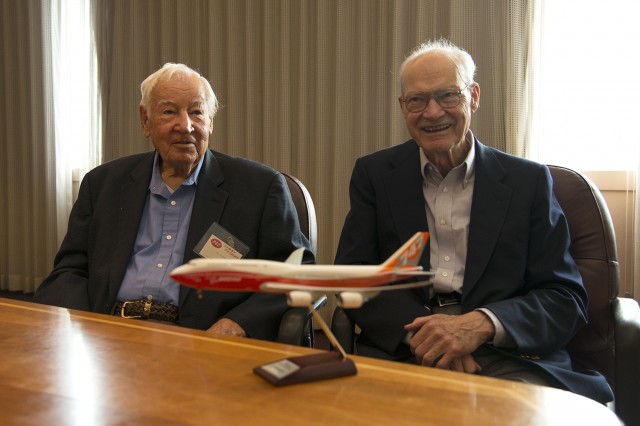
Joe Sutter and Brien Wylge – Photo: Kris Hull
Recently, the Museum of Flight in Seattle finished the first phase of restoring the historic first 747 to its original 1969 appearance. To celebrate this accomplishment, they hosted an afternoon seminar with Joe Sutter, who led the engineering team and is credited as the “Father of the 747”, Brien Wygle, the former Boeing Chief Pilot in 1969 who was in the right seat during the first flight, and noted author Clive Irving, who wrote one of the authoritative books on the 747. Before the main events on October 18th, we had the opportunity to sit down and talk with Sutter, Wygle, and Irving.
The 747 was an aircraft that was developed quickly by today’s standards, according to Sutter. “I was asked to investigate large aircraft designs in April 1965, Pan Am placed its first order in 1966, and we rolled out the first aircraft in 1968, with first flight in 1969, followed by entry into service in early 1970.” For an aircraft the size of the 747, three years from initial concept to rollout of the first model is still today unprecedented.
According to Irving, “It was a large program, and Joe was in the middle of the chain of command, and whenever there was a critical decision to be made, and no one else wanted to make it, Joe made it. He was the one in the end who signed off on everything, and took full responsibility.
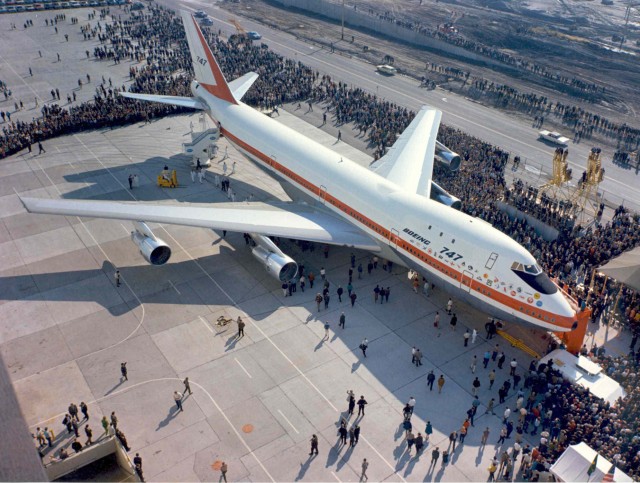
Roll out of RA001, the first 747 – Photo: Boeing
You will not find that speed in today’s environment.”It was a massive undertaking, and at one point, we were spending $5 million a day on the project. I was directed to cut 1,000 engineers by leadership, and I polled my crew and asked what they can do without; they said, ‘nothing, we need 800 additional engineers!'” said Sutter. “We were relegated to an old warehouse on the Duwamish River before the Everett factory was built, while the team heading up the government-sponsored SST program were housed in brand-new offices and buildings.”
When asked about how he felt being “relegated to a side project” compared to the high-profile SST program, Sutter replied, “We had a job to do, and we were going to build an airplane that did that job. We were going to get our job done, and we had the attitude that if we did a good job, the plane would have a great future.”
The design of the 747 has always been surrounded by a big rumor, in that when Boeing lost the Air Force CX-HLS competition, that ultimately led to the Lockheed C-5, they took their design and converted it to the 747.
“The Boeing CX-HLS proposal would have made a very lousy airliner,” Sutter said. “We started with a clean slate. Pretty much the only thing that survived from the Air Force competition were the high-bypass engines.”
“We went from engine technology that was roughly 1.5:1 on the JT3D, to 5:1 on the JT9D. The engine technology was really the major stumbling point on the aircraft,” said Wygle.
According to Irving, “The development of the airframe was ahead of the engines; however, the engines were themselves a major leap in technology, just as the aircraft was.” When asked if they were given any words of wisdom prior to the first flight of the 747, Wygle said, “Nothing ever really came up. There was no discussion of a Tex Johnson-style roll. It was a very professional approach to the flight.”
“However,” he continued, “when I piloted the first flight of the 737 in 1966, while Lew Wallick and I were taxiing out for that first take off, all of a sudden someone came across the radio and said ‘Remember Brien, pull back to go up, and forward to go down…’ nothing like that happened on the 747.”
“The first flight of the 747 was uneventful, aside from the issues we had with the flaps. It flew like a dream, and it was probably the easiest airplane to land,” commented Wygle.
According to Wygle, the initial fears from pilots and the general public about the size of the aircraft were quickly realized as unfounded. “The biggest mistake we made on the airplane was with the passenger entertainment system.” said Sutter. “It was not really a design issue, however, the buyers at Boeing chose the lowest bidder, and it turned out to be a nightmare!”
As we all know, the plane was a major success, and both Wygle and Sutter say the plane has lots of life left in it. They both predict that the coming year or so will hopefully see new orders for the latest iteration of the plane, the 747-8. When asked if he could have any of today’s technology back to the late 1960’s, Sutter replied, “I would have loved to use the computer technology we have today, and the composites. With the composites, we could build a lighter, stronger airframe. With computers, however, they do not enable you to design a better airplane, but they help you do things quicker, refine things quicker. The most important thing about designing an airplane is making sure you have people with brains doing the design work.”
Sutter does not hold back on that last point, as Irving pointed out. “Today, with all of this technology, we have a new aircraft with the 787, and it is an amazing piece of engineering, however, the management did not have the foresight to see that the outsourcing, trying to emulate the Airbus model, was a very bad idea.”
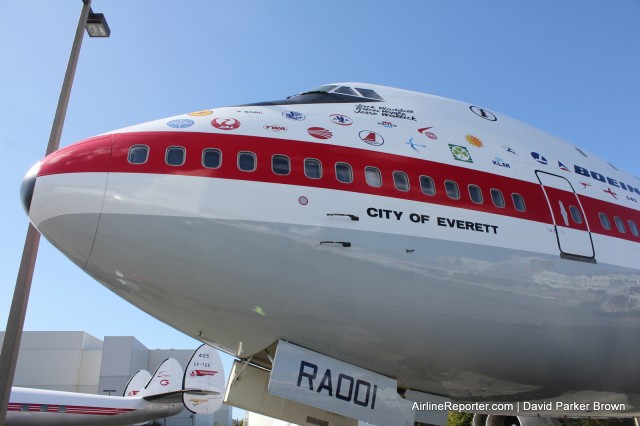
The City of Everett looks great in her new coat of paint
“Automation does not always make things better. If you pulled someone who had only flown analog aircraft, as the original 747 was, and placed them in a 787, they would be completely lost,” Wygle commented. “The automation these days is amazing, and it helps to take some of the workload off the pilots; however, everything that these planes can do today, we did 40 years ago with analog aircraft.”
“Automation does not always make things better when things go to hell,” added Sutter. “If something goes wrong, the Boeing philosophy is to have the instrumentation tell the pilot what the hell he should do, and when. The other major approach, where the computer can overrule the pilot, is not a good approach in the long run.”
With the 747, according to many analysts, in the twilight of its long and legendary production run, both Sutter and Wygle felt sentimental about the aircraft. “Airplanes like the 747 are niche players right now. Not only is the 747 a long-haul, high-capacity aircraft, but it is an excellent freighter. With the newer engines that are on the 747-8, I feel that the 747 will be around for years to come.”
“The cargo market is coming back, and nothing out there can handle the amount of cargo that the 747 can. There is no competitor available, or in work,” said Sutter. Wygle had a similar, if not more personal, perspective.
“Seeing that plane out there, seeing the way they restored it, it brings back a lot of memories. They did a good job with it!” he commented. “I feel a personal connection to that airplane, I always will.”
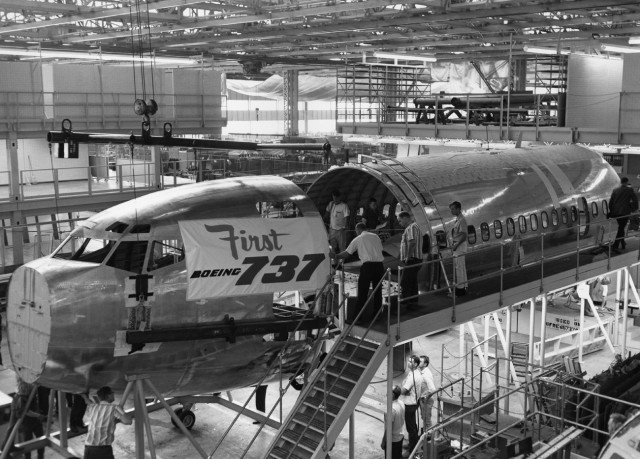
The first Boeing 737 under construction at Boeing Field in 1966 – Photo: Boeing
Sutter, however, when asked if he had similar sentimental feelings to the 747, replied that “I will always love that airplane, however, I am more fond of the 737. That plane was a big accomplishment that is still going strong.” Sutter’s comments are very true. He was one of the lead engineers on the most popular airliner in production, and was the leader of the team that was responsible for the look of the plane, so in a way, he could also be considered the father of the 737. He even co-owns the patent for the aircraft, for which Boeing paid him the customary $50 bonus of the time.
When the time came to pitch the 747 to airlines, Irving mentions that the sales team used a very unique item to sell Pan Am leadership (and more importantly, President & CEO Juan Trippe) the aircraft: a piece of rope. “The team went to Pan Am, and to illustrate the size of the aircraft, they took a long piece of rope and tied two knots nineteen feet apart. They went into the main boardroom and used the rope to visualize the immense size of the aircraft, and the board was impressed! ’˜My god, this is a big plane’ they said!’ ’œThe trademark hump actually helped the aircraft aerodynamically,’ Irving goes on. ’œIt also created the most easily and readily recognizable airliner in the world.’
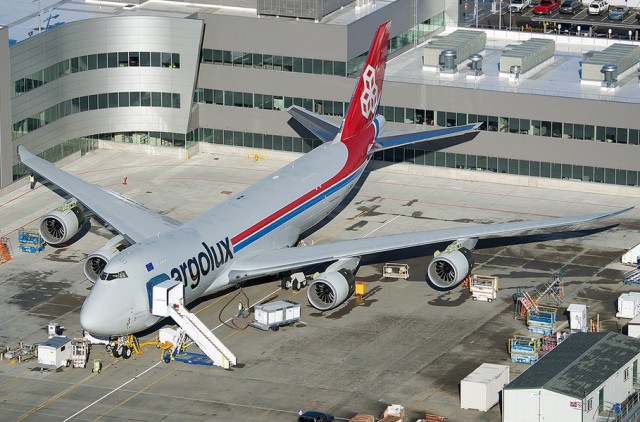
The freighter version of the Boeing 747-8 – Photo: Bernie Leighton | AirlineReporter
’œPan Am, mainly Trippe, initially requested a double-decker aircraft, and we studied several iterations of that design, including stacking two 707 fuselages on top of each other. That design was mainly a turkey. I knew immediately it wouldn’t work,’ Sutter comments on the initial design of the aircraft. ’œI knew there was a better way, so the team and I investigated a wide, single-aisle aircraft.
To accommodate the requirement that the aircraft also be a freighter, we decided to place the cockpit above the deck in a hump, so that cargo could be loaded straight through. When we showed the cabin mockup to Trippe, we were excited about the upper deck cockpit, but he just saw empty space with potential. Being the marketer that he was, his comment was that this will be a great place for passengers.’
According to Sutter, ’œthe hardest part of designing an airplane is right at the beginning. Sitting down and listening to what the customers want, and you need to talk to them and really hash it out, and predict the future needs. If you do it right, you will have a successful airplane. If you get it wrong, then you will have a financial disaster on your hands. Many aircraft have fallen into that latter category.’
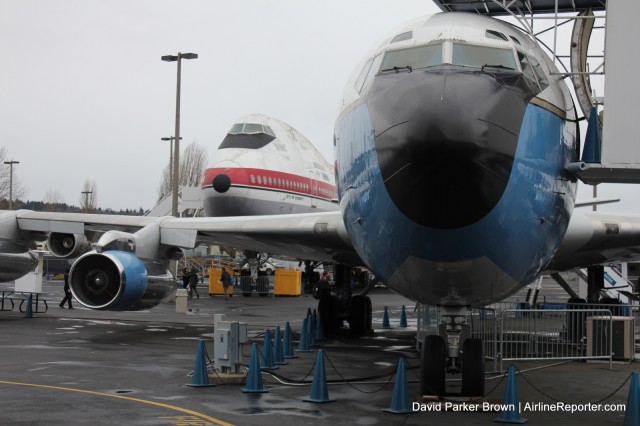
The airpark at the Museum of Flight, and the City of Everett before restoration (left)
With the initial phase of the restoration on RA001 complete, Dan Hagedorn, Senior Curator and Director of Collections for The Museum of Flight, was asked what is next for the aircraft, and the museum’s large airliner collection in general.
’œThe next phase is an expansion of the west campus, mainly the airpark. We are currently planning to enclose the airpark in two phases: first, a large canopy, sort of a covered open-air plaza, will be constructed over the airpark, and it will be large enough to house every aircraft that we have outside right now. The next phase, which will take a few years after the first, to allow aircraft to be moved around and added, and final restoration work to be completed, will involve fully enclosing the airpark, making it entirely climate-controlled.’
If all goes according to plan, ground should be broken in the spring of 2015, and construction of phase one will take nearly a year. ’œThere will be some headaches during this time,’ Hagedorn said; ’œduring the construction, we will have to close the airpark, and sadly, there will be no access to those aircraft for several months, but it will all be worth it in the end. We still have a lot of work to do on RA001, work that would be best done inside. We plan to fully polish all the engine cowls, and finally install the missing engine pylon panels. There is still a little work left to do inside, but not too much.’
When asked what he would really love to see on the completed aircraft, Hagedorn responded, ’œThis aircraft served its entire career as a test airplane. One of the most unique tests it accomplished was proving that a 747 could be used as an aerial refueler. I would love to get my hands on a refueling boom and modify it to the standards that were on this particular aircraft back in the mid-70’s.’
All told, the first 747, RA001 is a gem that changed the face of aviation and ushered in a new era of air transport. The men behind that creation were a breed apart, and they truly earned their nickname: The Incredibles!
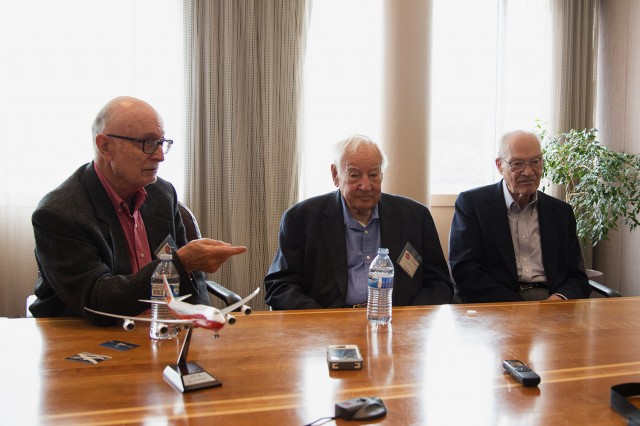
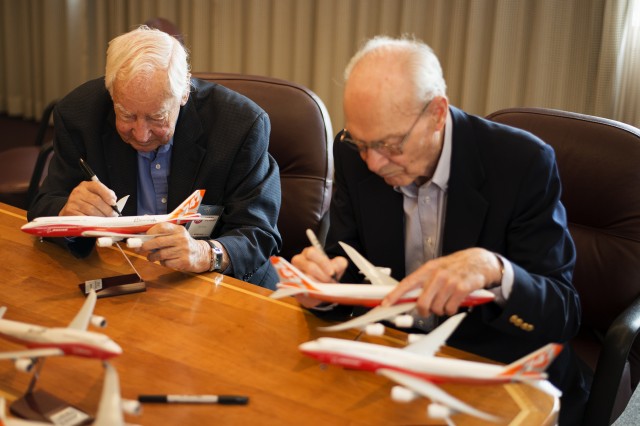
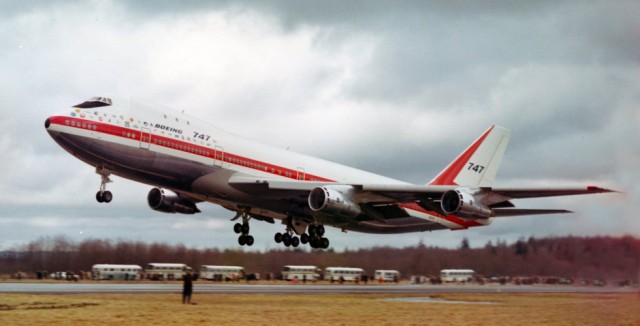
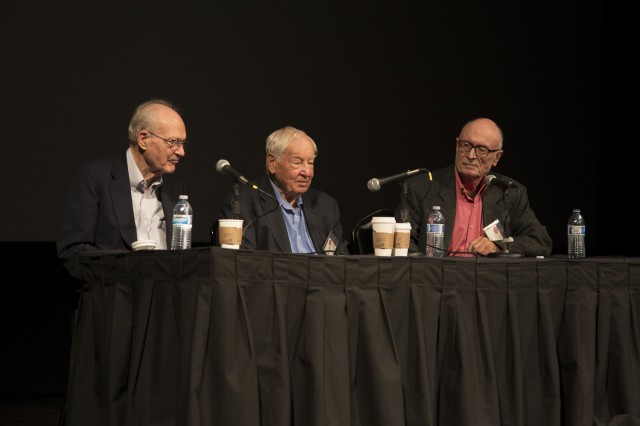
The best article I’ve read on this website by far. Nice to know they think the 747-8 has a future.
Glad you liked it Bryan — I was a huge fan too! Kris did an excellent job.
David
Great article. The 747 is a plane that holds a special place in aviation; its revolutionary design paved the way for modern wide-body aviation as we know it.
It’s abominable that the F o F has allowed RA001 – and their other historic aircraft – to languish outside; exposed to the harsh, wet weather in Seattle! Especially the Concorde! They’ve endured this harsh climate for numerous years!
I am guessing that you mean the MoF, not the FoF? 🙂
It is all about funding. They get donations, but when people donate they will say, “this money must go to……”
But finally RA001 got some attention and it will soon be covered and all will be right in the world 🙂
David
Ditto Bryan B.’s note above: best – and best written – I’ve ever enjoyed here. Thanks, B.B. -C
Thank you for this great article about this legendary aircraft!
I would love to have a chat with Mr. Sutter one day! 🙂
I worked on the 747 program and many times I saw Sutter and Stamper on the factory floor. That was a killer program and much different than the 707. 727, 767, and 777, all on which I worked.
The 747 had a feeling of desperation about it that the others didn’t have and some were worked to the breaking point. One felt proud to have survived it. I could be called one of the Incredibles but I’m not sure what that means now. The 747 will always be one of Boeing’s great accomplishments.
I am a big fan and admirer of Joe Sutter,and his achievement in getting the 747 in the air in that time scale . I was fortunate to be there for the first roll-out, and was impressed by the “press-on” attitude to overcome Flap / Landing gear and other problems while continuing production at an un-parelled level .
Grew up a Pan Am brat with mom a flight attendant and dad eventually captaining the 747 for many years JFK to Narita. Still have really vivid memories of, as a kid, watching him pull up to the gate in that Gigantic Freaking Plane. How nice it was you could welcome people at the gate!
Thanks for the great article.
My late significant other was a captain for United Airlines for 36 years. He flew many aircraft types for United, starting with the Viscount, but his favorite was the 474. He said it was the easiest aircraft to fly despite it’s size, at the time still being the largest commercial airliner flying. In his entire career with UAL, he never flew an Airbus…because he didn’t want to fly them!
Enjoyed this 747 story. I think dad (Glenn H. Jones) took the 747 roll-out picture. He was head of Boeing’s photo unit. He sent me a 16 X 20 copy of that roll-out picture while I was stationed in England in the Air Force. All the airman in my barracks were impressed! RA001 flew on my birthday, Feb. 9, 1969. I went to work on the 747 flight line when I got out of the Air Force in June. We were getting 747 numbers 3, 4 and 5 ready for their first flight and their participation in the flight test program. Crazy time on the flight line…..
Great article! Congratulations! I would like to share with you another article I wrote in the roll-out anniversary. Hope you liked it http://www.aeriaa.com/on-an-airplane-legend-boeing-747-rollout-45th-anniversary/
I just checked out that article you did and I want to tell you how much I appreciated the additional information and pictures your compiled….My wife’s father Edwin Gessele was the Crew Chief on RA 001 Queen of the skies for 20 years and flew with that airplane on its many test programs.. Please read my comments I just added today…May 18th…
Many Thanks to you, Lynn Claughton
My father was one of the draftsmen for the Boeing 747, I know he did the galley layout but not positive what other areas he worked on. He passed away about five years ago, but I found his employee badge with some of the original team pins still attached. Very proud to have it and proud my father was one of the men that help produce such a ground breaking aircraft.
Hey Michael,
Thanks for sharing your story about your father. That is a great find with his badge!
David
My wife’s father, Edwin Gessele, was a 40 year veteran in flight test and a 6 year Veteran in U S Naval Aviation during WWII. He was called back into active duty in 1951 during the Korean Conflict. Edwin was a true team player at Boeing Flight Test and having been so dedicated to his work and well liked by everyone, became an instant part of the cutting edge in the advancement of Boeing Airplanes in world aviation. For nearly 20 years he was the Crew Chief on the “Queen of the Skies”, RA 001 and traveled with that airplane used on many test programs, Edwin took pride in referring to that magnificent airplane as “his airplane”, not uncommon among crew chiefs In addition, he was assigned Crew Chief on all of the various World Sales Demonstration tours, every one of them, up to and including the 767 World Sales Tour, Of significance on the day of departure, with a number of ” Boeing Top Brass on Board” departing from Boeing Field, encountered a bird strike. Edwin told me it was a loud POP! and it smelled like” burnt chicken in the airplane.. Tommy Edwards was flying the red and white marked 767 on that world tour. Eventually somewhere over the Aleutian Islands, the decision was made to came back to Everett and replaced that engine as they could not take a chance having only a one day grace in their month long world schedule. That tour was successfully completed on time! Anyone recall that incident?
Mr Gessele was part of the earliest development of the 737 program and I have a picture of the # 6 737 in which he was pictured showing it still being “EXPERIMENTAL”. I was informed that was the first 737-200 which showed United Airlines colors. I would imagine Mr Bogash would have first hand awareness of first 737 production and could explain 737 #6? I was informed CEO Bill Allen personally took down the ‘EXPERIMENTAL’ sign and replaced it with “CERTIFIED” That’s GOOD hands on Management in my opinion!
Going back some years, I have a great picture of the 1964 727 “Latin American Tour” which the 727
N 727000 that was used on that tour.. It would be easy for these airplanes to be misconstrued with them having all looked identical. I could provide a copy to anyone interested in that photo…
There are so many stories, for example: Edwin told us “it took about 5 guys to throw Jack Wadel in the swimming pool after he took off in the Air Force ‘COMMAND POST’ 747 which broke a world lift record at Edwards AFB after having been fitted with its new GE engines”….”But that record was not official because they never weighed in before take off.’ Jack Wadel, first to fly the 747, was a very strong man and kept in great physical condition according to Edwin was a dedicated runner. Many stories and little space to document them.
Please let us know if anyone remembers EDWIN GESSELE in Flight Test. He was very well known for his kind, soft spoken manner in which he used to lead by example.
On his most significant and final world tour, Edwin Gessele departed the runway of life on February 11, 2017, almost 93 years old , bound for the skies of heaven. He was truly the finest man I ever knew….
another accomplishment babyboomers couldn’t match. like going to the moon, or in their case, to mars. only good they could do is create the internet, and even that was half-assed and half-done by them, because it didn’t really catch up until the 90’s.